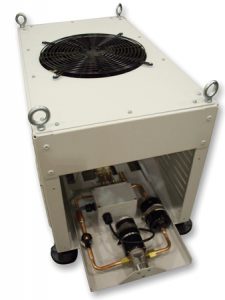As a follow-on to last year’s announcement by Parker Hannifin of a “rack-ready” two-phase evaporative cooling system for wind turbine systems, the company has developed a stand-alone configuration of the system as a drop-in replacement to easily retrofit existing wind turbine cooling systems (traditionally air- or water-based). Parker’s stand-alone cooling system is fully scalable and available in three configurations with capacity to handle from 25kW-50kW-100 kW and is 50 percent lighter and more compact than legacy air and water cooling systems.
Using the same patented two-phase evaporative precision cooling system as Parker’s rack-integrated configuration, the stand-alone system provides a convenient way to “upgrade” the system and greatly improve wind turbine systems’ efficiency and reliability. The Parker cooling system delivers up to 40 percent increase in power throughput and can more than double electronics density in the same space, which is a major benefit in a nacelle or wind tower where space is at a premium. Due to the non-conductive, non-corrosive nature of the coolant, the system is also inherently safer and highly reliable.
The system features Parker’s two-phase evaporative precision cooling patented technology, which uses a non-conductive refrigerant in conjunction with a modular cold-plate IGBT design, to circulate in a closed loop. The system includes a small pump to deliver a just enough coolant to the evaporator (usually cold plates) to optimize the heat from the particular device. The vaporized content is then pumped to the system’s heat exchanger, where it rejects the heat to the ambient and then condenses back into a liquid, completing and repeating the cycle.
Parker’s precision cooling systems are 50 percent lighter and smaller than traditional air and water cooled systems, and fit easily into the nacelle, while enabling up to 40 percent higher throughput from system electronics, and up to twice the density in the same space. All this translates to the overall lower system cost, with inherent safety and simplified maintenance, due to their modular and scalable design. All critical wind turbine systems can benefit from these integrated cooling systems, including the inverter, reactor, and generator as well as other electronics either in the nacelle or in-field containers. Parker’s two-phase evaporative precision cooling system is now available in two convenient configurations: the new stand-alone cooling unit, servicing multiple systems with localized cold plate kits (see photo); and the rack-ready integrated design for each wind turbine system (introduced at AWEA Windpower 2011). For more information visit www.parker.com/pc.

























